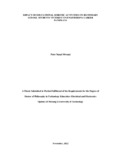| dc.description.abstract | Science, Technology, Engineering and Mathematics related careers are important in preparing any nation for development. There has been low interest by the secondary school students in the STEM fields and as such teaching and learning in these areas must be reconsidered. It is important develop activities and integrate them in these subjects in order to expose the students to Engineering and afterwards assess the impact of the exposure to the interest in these subjects. Some of the activities that could be developed and implemented include educational robotic activities. Most of the existing educational robots are expensive and are not affordable to most of the public secondary schools in the developing countries. In this study two low cost robots were designed for purposes of education which included robotic car and a robotic arm. This was followed by development of robotic activities based on the robots, integration of the activities to Physics and Mathematics and the assessment of the impact of the integrated activities to learning of the subjects and choice of a career pathways towards Engineering. This research was guided by constructivism and constructionism theories. A mixed methods research design was adopted in this study. The research was conducted in secondary schools in Kangema Sub-county, Murang’a County in Kenya. The target population included 2,478 Form 2 students where 270 students were selected through simple random sampling method. The selected students were introduced to the educational robots and robotic related activities. A questionnaire, a pre-test and post-test examinations and an interview schedule were used to collect data. Quantitative data was analyzed using descriptive statistics such as frequencies, percentages and measures of central tendency which comprised of the mean and standard deviation. Inferential statistics was also used in analyzing the quantitative data, specifically sign test, paired sample t-test, correlation, Chi-Square test and One-Way ANOVA. From this study, a low-cost robotic kit was designed and developed by adopting locally available materials and readily available programs that are simple to understand and modify. Precollege robotic activities that were divisible into simple tasks were developed based on the designed kit. The developed robotic activities were integrated into Physics and Mathematics topics based on interdisciplinary, adaptability, interest and problem solving themes. The findings on impact revealed significant difference between the pre-test and post-test with a p-value < 0.0001 and therefore the robotic activities had a significant impact on students’ decision to choose a subject combination towards an Engineering career pathways. The study recommends that the government should facilitate the integration of educational robots in the current Science, Technology, Engineering and Mathematics curriculum through partnerships with research organizations such as universities and other research bodies to develop low cost and simple to use educational robotic kits. The study also recommends that through policy makers in education, the curriculum should be reviewed so as to adopt educational robots as a teaching/learning tool and teachers/instructors retrained on robotic use in education. Future studies should be conducted on the applicability of educational robotics in other subjects such as Biology, Geography, Chemistry, Agriculture and in Arts related subjects. The current study should be replicated in lower grades owing to the fact that the Kenyan curriculum is in transition from the traditional 8-4-4 system to the Competency Based Curriculum. | en_US |

